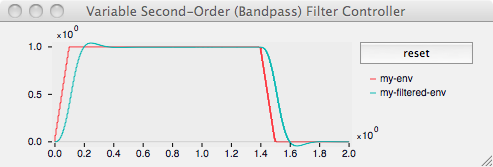Variable 2nd Order (Bandpass) Filter
Description
Given a 1-dimension input, provides a Second Order IIR filter output with a variable center frequency and bandwidth.

Syntax and Default Values
The variable-second-order-filter controller (1-dimensional) can be created using the following Mlys (Max), mlys.lua, or Lisp syntax:
In Modalys for Max, this object is named mlys.variable-second-order-filter:

An 1-dimensional input controller must be connected to the first inlet.
The dimension is set to 1 under the hood.
💡If a second inlet is given, you can connect a controller representing the frequency; if there is a 3rd one, then it will be for the bandwidth.
create_controller{kind="variable-second-order-filter",
period=-1, -- optional
input=<input controller>, -- dim = 1!
frequency=700, -- value or a 1-dimensional controller
bandwidth=20, -- value or a 1-dimensional controller
name="Variable2ndOrderFilter"}
(make-controller 'variable-second-order-filter
dimension
period
input
frequency
bandwidth)
Parameters
The 'variable-second-order-filter controller takes five arguments:
- dimension: dimension of the input and output controllers (must be 1, automatic for mlys.lua or Modalys for Max)
- period: the time between the updates of the controller. Should be -1 (automatic). If zero, then it updates every sample.
- input: filter input (a 1-dimensional controller).
- frequency: controller specifying the center frequency in Hz (dim=1).
- bandwidth: controller specifying the bandwidth in Hz (dim=1).
The dimension must be 1 for all controllers.
The center frequency and bandwidth parameters should be both be controllers of dimension 1. Note that there is no amplitude controller for this filter. Amplitude gain is internally set to 1, but resonances caused by very narrow bandwidths could result in very high amplitude values.
Discussion
The variable second order (bandpass) filter can be used for a variety of purposes, but generally is used either to smooth out envelopes or create resonances from impulses. Using a low frequency and fairly wide bandwidth, it can smooth out envelopes (a graph of this example is shown in the image, above):
(setq my-env (make-controller 'envelope 1 '((0 0.0) (0.1 1.0) (1.4 1) (1.5 0)) ))
(setq my-filtered-env (make-controller 'variable-second-order-filter 1 0 my-env (const 1) (const 5)))
(setq my-noise (make-controller 'noise 1 0 (list (const 44100) (const 0.25) (const 0.25) (const 1) (const 1)) 10))
(setq my-filtered-noise (make-controller 'variable-second-order-filter 1 0 my-noise (const 440) (const 1)))
★